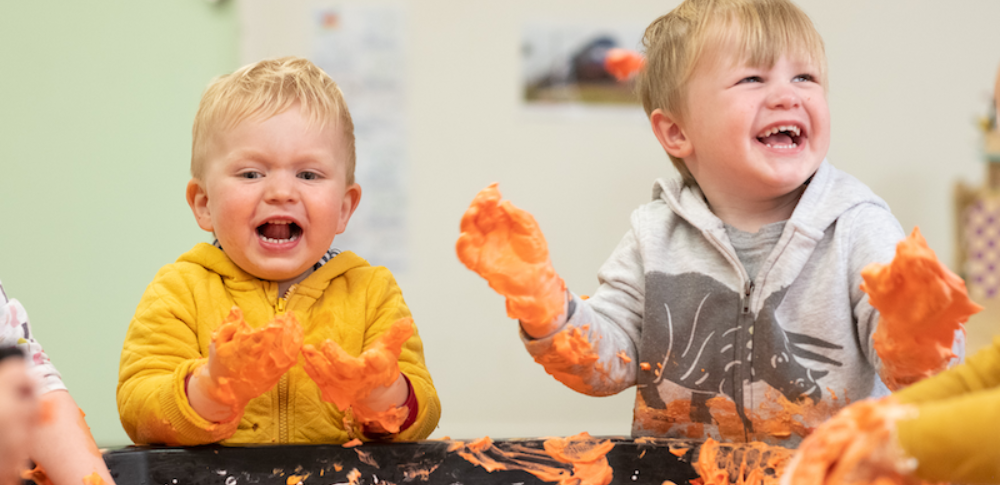7 sensational sensory play ideas
Published on Tuesday, 06 March 2018
Last updated on Thursday, 20 October 2022

According to our colleagues at Goodstart Early Learning, sensory play is any activity that stimulates a young child’s senses: touch, smell, taste, movement, balance, sight and hearing.
Sensory play activities facilitate discovery and learning by encouraging children to use scientific processes while they play, create, investigate and explore. Offering a wide range of sensory experiences is very beneficial for young children, research shows it can help build neural pathway connections, which improve a child’s ability to engage in more complicated learning.
Sensory play can also support children's fine and gross motor development, cognitive growth, flexibility in thinking, confidence and problem solving and communication skills.
While you could argue that most play is 'sensory', in one way or another in that it stimulates a child's senses, sensory play in early childhood settings implies a more deliberate and planned approach to an activity. Providing children with an opportunity to engage in activities they may not be able to do at home offers fertile ground for exploration and learning, and to help you think 'outside the sandbox' in this regard, we've done some research and created a list of seven sensational sensory play suggestions you may like to try in your service.
Rice and ice
This messy and highly textural activity, created by Learning4Kids combines ice cubes in primary colours with rice. As the ice melts the colours combine and dye the rice. There are plenty of sensory experiences available here, including touch, sight, hearing and movement and learning opportunities galore, including the scientific concepts of cause and effect, colours as well as rhyming, just to name a few.
Garden soup
This activity is light on resources but does require your service to have access to an outside area. Using a big pot or cauldron filled with water, create a 'soup' with treasures collected from the garden. Stir up a stew of aromatic plants such as flower petals and eucalyptus leaves, talk about which ingredients sink and float and how the water changes colour.
DIY colourful sand
This wonderful activity from Jode, the Empowered Educator, is the ideal sensory play activity for early childhood services. Through creating their own jar of colourful sand, children have the opportunity to experiment, observe transformation, touch the sand as it changes texture, scoop it into jars, mix the colours and discuss the process.
Edible finger paint
Young children who are still exploring the world via their mouth will adore this activity and benefit from the range of learning opportunities on offer. Finger painting gives children the opportunity to touch and experiment with texture and colour and unleash their creativity. Many children don’t have the opportunity to engage in open-ended art projects at home due to mess, which is another great excuse to give this activity a whirl.
Parachute play
Gathering in a circle with a parachute offers myriad sensory learning opportunities, especially if you head outside under the shade of a tree. Children can refine their gross motor, perception and balance skills. Conduct basic science experiments by placing things of varying weight in the middle of the parachute and observing what happens when they are tossed in the air. Place a ball in the middle of the chute and encourage children to use their voices to communicate strategies for keeping it rolling. This worksheet by Child Care Lounge has a load of great ideas to try.
DIY rainbow water beads
Water beads are made of tapioca pearl, which you can easily find in an Asian supermarket, they are quick to make and once they are cool can be played with immediately. Squish and squelch them, count them, bounce them, add food colouring to cooked pearls and let them sit for an hour so the colour can seep in.
Digging for worms
This simple, cost effective activity offers children the opportunity to search for and catch spaghetti worms from a tray full of soil. Apart from the fine motor skills necessary to ‘catch’ the worms, this activity gives children the chance to practice their counting and communication skills, experiment with the different textures of the slimy worms and lumpy soil and discuss the important role of worms in the ecosystem.
References
Exploring the benefits of sensory play by Goodstart Early Learning
Related Articles

Why risky play is important for young children
Providing safe opportunities for risky play in early childhood settings.

Sensory play in child care
Sensory play might involve making mud pies and smelling the daisies, but there's more to this immersive activity than meets the eye.

The lifelong benefits of play
Play is a great way for children to amuse themselves and live in the moment, but according to the experts, play offers much more than just fun and games.

